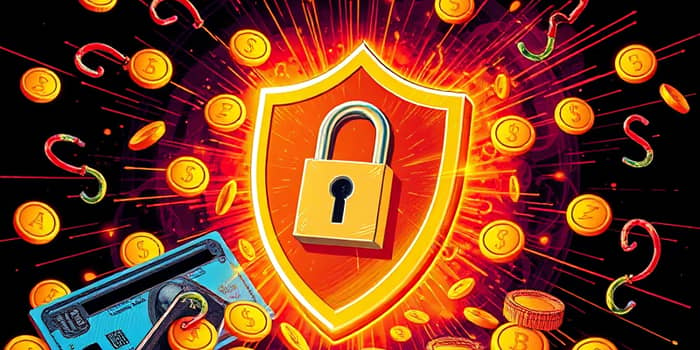
Imagine receiving an urgent call from your “bank” warning of suspicious activity, only to realize moments later it was a scammer seeking your account details. This scenario plays out thousands of times each day, leaving victims both emotionally shaken and financially drained. In a world where digital connections bridge distances, fraudsters exploit every vulnerability to gain unauthorized access to your hard-earned wealth.
Protecting your assets means recognizing how these schemes evolve. By understanding common traps and adopting proactive protection strategies for your finances, you can transform yourself from a potential victim into a resilient defender. This article will guide you through the most prevalent scams, reveal telltale warning signs, and equip you with actionable tactics to secure your future.
Financial fraud has reached unprecedented levels worldwide. In the United States, identity theft affects 24% of scam victims, while gift card and e-commerce scams account for 19% and 16%, respectively. Globally, shopping scams plague 22% of consumers, and investment cons impact nearly one in five people. These figures underscore a stark reality: no demographic is immune to deception.
Vulnerable groups bear a disproportionate burden. Adults over 60 are five times more likely to fall victim to tech support scams, resulting in over $175 million in losses in 2023 alone. Event ticket scams have seen searches spike by 950% over five years, leading to more than £1 million lost in a single UK fraud wave. Meanwhile, over 80% of crypto and investment scam targets report financial losses, with median losses approaching $3,800. Such alarming data make it clear that vigilance and education are more critical than ever.
Beyond financial consequences, these scams can erode trust, harm mental health, and create lasting stress. Victims often feel isolated or embarrassed, delaying reporting and recovery. By sharing our stories and knowledge, we can create a supportive environment that encourages prompt action and collective awareness.
Scammers combine creativity and technology to craft schemes that can seem legitimate at first glance. From straightforward phishing attempts to sophisticated AI-driven deceptions, understanding how these frauds operate is your first line of defense. Below are some of the most widespread scams you should recognize and avoid:
Triangulation fraud, for example, uses stolen credit cards to process legitimate-looking orders, creating confusion when customers request refunds or exchanges. This tactic highlights the need for robust transaction monitoring and vigilance when discrepancies arise.
Beyond these core threats, hybrid scams blur traditional boundaries. For example, a romance scammer may suddenly pitch an investment opportunity, while an employment scammer collects sensitive data under the guise of background checks. Remaining skeptical of unexpected requests is vital to avoid these layered cons.
To highlight their impact, consider the following data snapshot showing how often people fall prey to these ploys and the typical financial fallout:
Once you identify these warning signs, stop and verify. Never share personal data through links or phone numbers provided in unsolicited communications. Instead, contact companies through official websites only and confirm unusual requests via a second channel.
General safety measures include using credit cards for online purchases to leverage chargeback protections and enabling multi-factor authentication on all important accounts. Install reputable security software and keep systems updated to guard against malware and unauthorized access.
For specific scenarios, follow these tips:
Remember that prevention is a mindset, not a one-time action. Regularly question unexpected requests, educate yourself about new scam forms, and practice restraint when emotions spike during urgent appeals.
Looking ahead, fraudsters will increasingly deploy generative AI and voice-cloning to launch more convincing vishing and phishing attacks. Vishing incidents spiked by 442% in late 2024 as criminal networks leveraged AI-generated voices to mimic trusted contacts. At the same time, deepfake videos on social platforms may be used to impersonate public figures and solicit investments.
Cryptocurrency and digital asset frauds are also expected to rise in parallel with market growth. Scammers exploit the decentralized nature of crypto, offering fake wallets, fraudulent token launches, and deceptive giveaways. Meanwhile, hybrid scams that mix romance, investment, and tech support elements will continue to challenge traditional detection methods, making continuous learning essential for every individual.
Financial security is a journey, not a destination. Regularly review bank statements and credit reports to spot anomalies early. Subscribe to reputable fraud alert services and community forums where new scam patterns are discussed in real time.
Educating yourself and your loved ones can create a protective network: share insights, discuss recent attempts, and establish protocols for verifying unusual requests. Consider setting up watchlists for suspicious domains or email addresses and lighting up notifications on your financial accounts to catch unauthorized transactions before they escalate.
Ultimately, combining continuous education, sound security measures, and healthy skepticism will transform you into a formidable opponent against fraud. Engage with financial advisors or local consumer protection agencies to stay updated on emerging threats. Many nonprofits and community centers offer workshops and materials tailored for seniors and small business owners.
Your assets, retirement nest egg, and peace of mind depend on staying one step ahead of ever-evolving threats. Arm yourself with knowledge, verify everything, and foster a culture of caution—because in the fight against financial scams, vigilance is your greatest asset.
References













